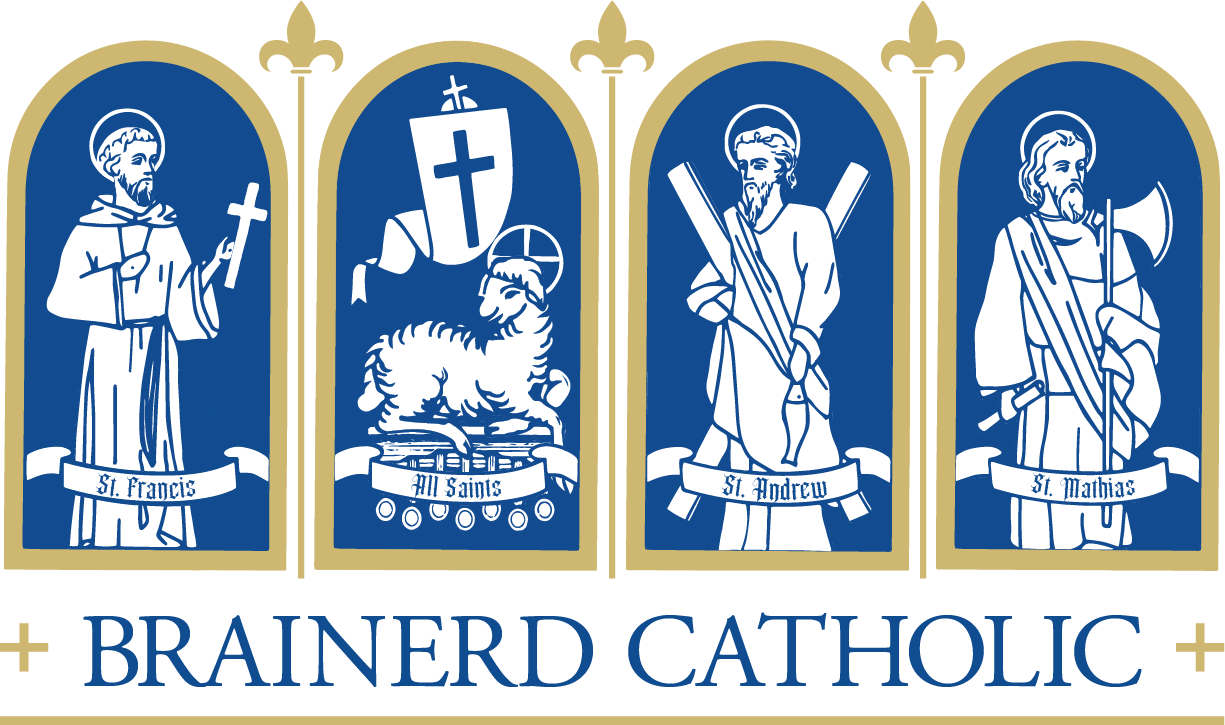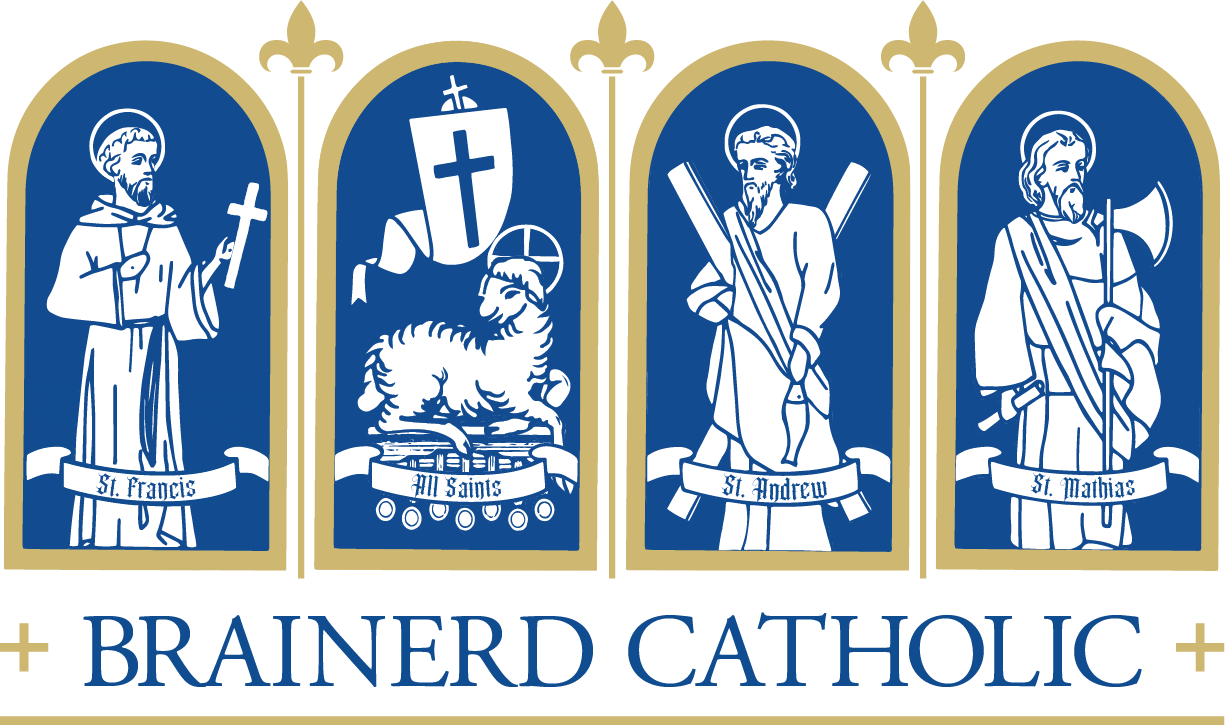Brainerd Catholic
Ad Orientem
What is ad orientem and Why are we practicing it?
The goal is to deepen our appreciation of every Mass we attend (whether ad orientem or versus populum) by periodically experiencing the Mass celebrated in a new and traditional way. Bishop Felton has issued directives for offering Mass ad orientem for the Jubilee Year of 2025.
-
Ad orientem is Latin for “toward the east.” The Mass is celebrated ad orientem when the entire congregation—including the priest, who is head of the assembly—faces the same direction toward God in prayer. The alternative is celebrating the Mass versus populum, when the priest faces “toward the people.” Other than the direction of the priest, the Mass remains entirely the same.
-
The eastward direction holds deep biblical and symbolic significance for Christian prayer. Since the Garden of Eden was located “in the east” (Gen. 2:8), early Christians believed that praying in this direction reconnected them to the pre-fall relationship with God and symbolized their hope of returning to paradise. Additionally, Christ tells us He will come again “from the east” (Mt. 24:27), so praying toward the east serves as a symbolic gesture of anticipating His Second Coming. As a result, Christians have traditionally built churches with altars facing east, and arranged cemeteries so that the feet of the deceased point toward the east. For us today, even if our modern churches do not face east geographically, celebrating the Mass ad orientem can orient us toward the “liturgical east”, root us in this deep biblical and symbolic tradition, and enrich our understanding and experience of the Mass.
-
To the average churchgoer, the two most noticeable changes in the Mass after the Second Vatican Council (1962–1965) were the disappearance of Latin and the priest celebrating versus populum. However, those who read the actual texts of the Council are often surprised to find not only no mention of these changes but even at times the opposite. For example, with regard to the place of Latin in the Mass, the Council document on the liturgy explicitly states, “the use of the Latin language is to be preserved” (Sacrosanctum Concilium, 36.1). Similarly, there is no mention in the Council documents of ad orientem or versus populum. It was the post-conciliar instructions that permitted versus populum (never requiring it) and it subsequently became widespread. Vatican II, therefore, did not prescribe a change from ad orientem to versus populum (more on this in the next question).
-
No. First of all, it can be confusing when people say “the Latin Mass” because sometimes they are referring to the Mass as it was celebrated prior to Vatican II (otherwise known as the “Traditional Latin Mass”, the “Tridentine Mass”, or the “Extraordinary Form of the Mass”) and other times they can be referring to the current Mass but celebrated in Latin (as opposed to English, Spanish, or any other language). The current Mass celebrated since Vatican II is called the “Novus Ordo” or sometimes the “Ordinary Form of the Mass.” It’s important to note that the pre-Vatican II Traditional Latin Mass and the post-Vatican II Novus Ordo are two distinct forms of celebrating the Mass.
That being said, it’s also worth noting that the rubrics of the Novus Ordo not only permit ad orientem but even presume it. For example, before the sign of peace, the rubrics instruct the priest, “The Priest, turned towards the people, extending and then joining his hands, adds: The peace of the Lord be with you always.” The reason it says, “turned towards the people” is because it presumes he is otherwise not facing the people—i.e. not celebrating the Mass versus populum. By celebrating the Mass ad orientem, therefore, we are not approaching any closer to the Traditional Latin Mass, but celebrating the Novus Ordo according to the rite.
-
Referring to ad orientem as the priest “turning his back on the people” is as common as it is unfortunate. It presupposes that the priest is the focal point of the liturgy. This unfortunate presupposition, it has been suggested, is likely an unintended byproduct of celebrating the Mass versus populum, which more easily lends itself to the priest becoming the main focus. One advantage of ad orientem is that it deemphasizes the idiosyncrasies of the priest and removes the temptation to treat the liturgy as a “performance” for the people. For these reasons, it’s preferable to say that the priest faces the same direction as the people (east). To say that the priest “turns his back on the people” indirectly reinforces clericalism in the liturgy.
-
Obviously, not all priests will experience ad orientem or versus populum in the same way, but among those who like ad orientem, many report being less distracted in prayer because their posture reinforces who they are addressing. They also experience less pressure when celebrating ad orientem, since, unlike versus populum, not all eyes are directly on them. Finally, because they must turn and face the people at three significant moments—“Pray, brethren, that my sacrifice and yours may be acceptable to God, the Almighty Father,” “Behold the Lamb of God...,” and “The peace of the Lord be with you always…”—priests often find that their role and identity as priest and mediator is fortified and strengthened.
-
First, be open! Virtually every Mass prior to 1970 was celebrated ad orientem. This orientation in prayer is deeply rooted in our Catholic tradition, so one thing we cannot say is that it “doesn’t work” or that it is “ineffective” in helping us encounter Christ in the liturgy and handing on the faith. Second, the orientation of the priest can help us focus on who is being addressed in the prayer. When the priest is facing you, he is addressing you, so act and respond accordingly. When he is facing the altar, he is addressing God, so unite your prayer to the priest’s and hear your voice in his prayer. Finally, share your experience with others and support them in their experience.
Brainerd Catholic will be celebrating Masses ad orientem on the 2nd Sunday of each month throughout 2025.
-
2nd Sunday of the month
7:30AM - St. Francis
8:00AM - St. Mathias
9:00AM - St. Francis
10:00AM - St. Andrew’s
10:30AM - All Saints
11:15AM - St. Francis -
Monday after 2nd Sunday
8:15AM - St Francis

